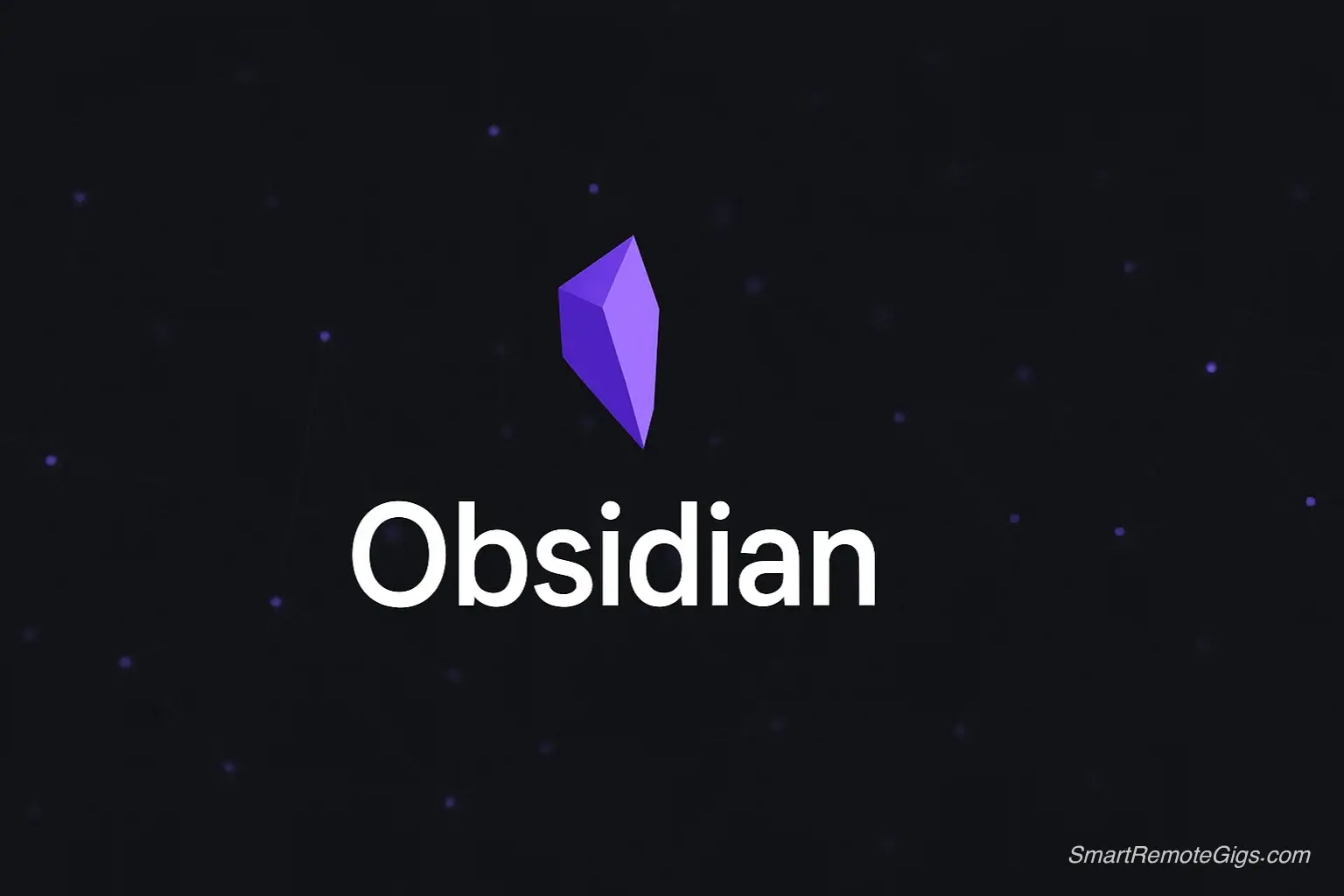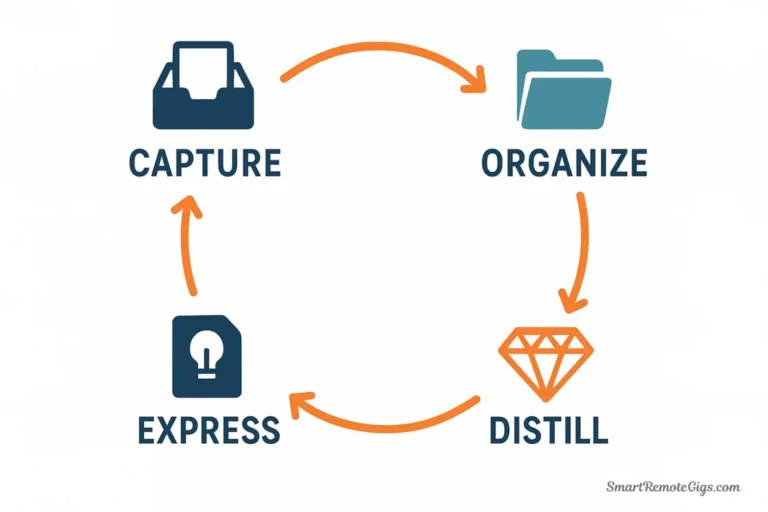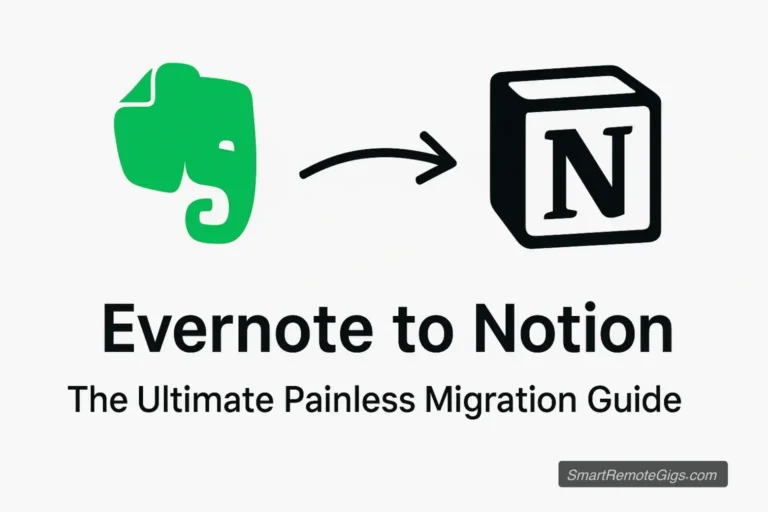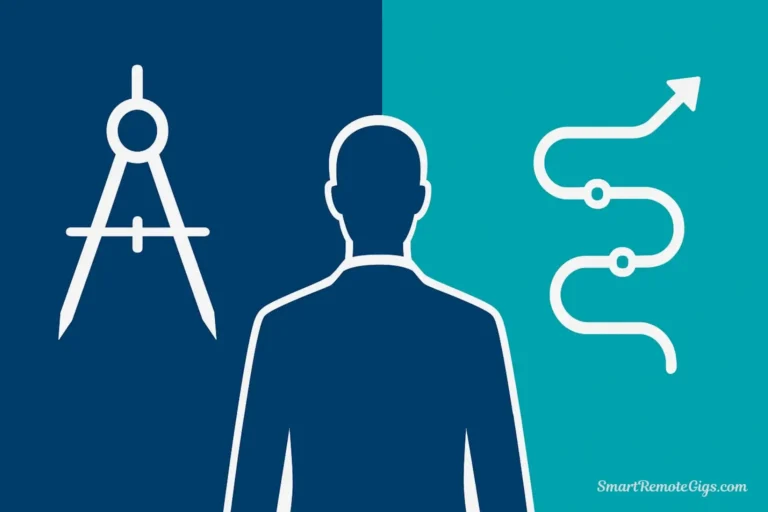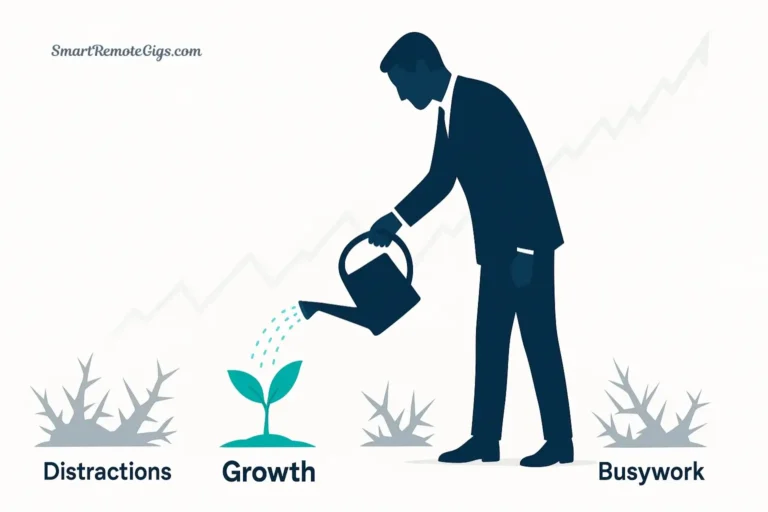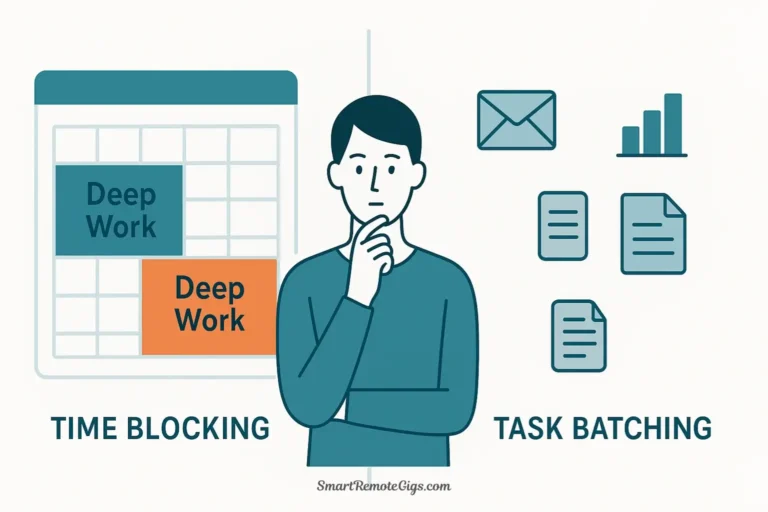Most note-taking apps promise to organize your thoughts. This Obsidian Review looks at a different promise: it helps you think better. This isn’t another cloud-based productivity suite trying to do everything for everyone. It’s a deliberate tool built for people who want to create a lasting, interconnected knowledge base that truly belongs to them.
In an age where our digital lives are scattered across corporate servers and subscription services, Obsidian takes a radically different approach. Your notes live on your device, in plain text files that will outlast any company or platform. But this philosophical commitment to user ownership comes with trade-offs that aren’t right for everyone.
After two years of daily use, building a personal knowledge base of over 1,000 interconnected notes, and testing it against every major alternative, this Obsidian Review will help you understand whether Obsidian aligns with how you think and work. The answer isn’t simple—but it’s worth understanding.
🎯 The Verdict in 30 Seconds
Overall Rating: 9.4/10
Bottom Line: For those who want to build a truly personal, lasting knowledge base, Obsidian is unmatched. It’s an investment in long-term thinking, not just another app. But it requires patience, curiosity, and a willingness to build rather than consume.
Perfect For:
- Researchers, writers, and knowledge workers building long-term projects
- Privacy-conscious users who want full control over their data
- People fascinated by connections between ideas (PKM enthusiasts)
- Those who prefer local storage over cloud dependency
Skip If:
- You want something that works perfectly out of the box
- Team collaboration is your primary need
- You prefer simple, linear note-taking
- Technical setup and customization sound intimidating
🏛️ The Obsidian Philosophy: Your Data, Your Rules
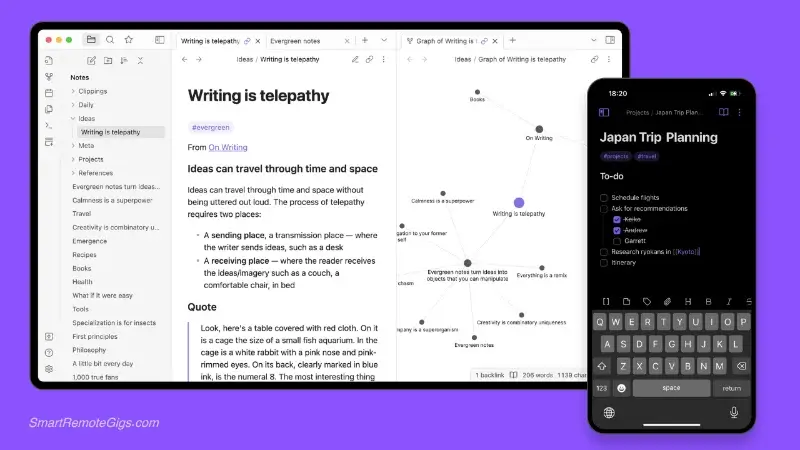
Obsidian’s core philosophy centers on a revolutionary idea in today’s software landscape: you should own your thoughts. Every note you create in Obsidian is stored as a plain text Markdown file on your local device. No proprietary formats, no cloud lock-in, no subscription required to access your own data.
This means your notes from 2025 will still be readable in 2045, regardless of whether Obsidian the company exists. You can edit them in any text editor, back them up anywhere, and migrate to any future system without losing formatting or content. It’s digital permanence in an age of planned obsolescence.
But local storage goes beyond just ownership—it enables speed and privacy that cloud apps can’t match. Your search results appear instantly because they’re querying files on your device, not traveling to distant servers. Your sensitive research, personal reflections, or business notes never leave your control.
The Markdown foundation also means human-readable formatting. Instead of complex formatting menus, you use simple syntax like **bold** and # Heading. This might seem limiting initially, but it creates consistent, portable notes that focus on content over appearance.
This philosophy attracts a particular type of user: people who think in systems, value privacy, and prefer building custom workflows over accepting predefined structures. If you’re someone who enjoyed tinkering with computers, customizing software, or building complex spreadsheets, you’ll likely appreciate Obsidian’s approach.
🏗️ The Three Pillars of Obsidian’s Power
Bidirectional Linking & The Graph View
Obsidian’s linking system transforms note-taking from a filing cabinet into a web of interconnected thoughts. Instead of organizing notes in rigid hierarchies, you create connections by linking related concepts using simple [[double brackets]].
These aren’t just hyperlinks—they’re bidirectional relationships. When you link Note A to Note B, both notes automatically show they’re connected. Over time, this creates a network of knowledge where ideas naturally cluster around central concepts.
The Graph View visualizes these connections as an interactive web of nodes and links. It’s not just pretty—it reveals patterns in your thinking you might not have noticed. Isolated notes appear as disconnected dots, suggesting areas that might benefit from more connections. Dense clusters show your core areas of interest and expertise.
But the real power emerges over time. After months of linking related concepts, you’ll find unexpected connections between disparate ideas. A note about productivity techniques might connect to one about psychological research, which links to thoughts about team management, revealing insights that wouldn’t emerge in traditional folder-based organization.
This linking approach supports methodologies like Zettelkasten, where atomic notes (one idea per note) connect to form complex arguments and insights. Many users report that this system helps them think more clearly and discover novel connections between concepts.
Infinite Customization with Plugins

Obsidian’s plugin ecosystem transforms a simple note-taking app into a personalized thinking environment. The core app is deliberately minimal, but the community has created hundreds of plugins that add specific functionality without bloating the base experience.
Essential plugins that enhance daily workflows include:
Calendar Plugin: Adds a visual calendar for daily notes and planning. Perfect for users who want to combine journaling with note-taking, creating automatic links between dated entries and project notes.
Kanban Plugin: Transforms notes into Kanban boards for project management. You can create task boards that link to detailed project notes, combining planning with knowledge capture.
Dataview Plugin: Turns your notes into a queryable database. Create dynamic lists that automatically update based on tags, dates, or metadata. For example, automatically generate a list of all books you’ve read this year, complete with ratings and notes.
Templater Plugin: Automates note creation with dynamic templates. Set up templates for meeting notes, daily journals, or project planning that automatically fill in dates, generate unique identifiers, and create relevant links.
The plugin system means Obsidian grows with your needs. Start simple with basic note-taking, then gradually add functionality as your system matures. Unlike monolithic apps that force you to adopt their entire feature set, Obsidian lets you build exactly the tool you need.
A Blank Canvas for Your Thoughts
Obsidian’s writing environment is designed to disappear, leaving you alone with your thoughts. The interface is clean and distraction-free, with formatting options hidden until needed. You can switch to full-screen mode that eliminates all interface elements except your text.
The Markdown syntax creates a consistent writing flow. Instead of reaching for formatting buttons, you develop muscle memory for simple syntax that keeps you focused on ideas rather than appearance. Headers, lists, and emphasis become automatic, letting you maintain writing flow while creating well-structured documents.
Multi-pane layouts let you reference multiple notes simultaneously—essential for research and complex writing projects. Open your outline in one pane, reference materials in another, and write in a third. The spatial arrangement of information mirrors how many people naturally think about complex topics.
The linking system integrates seamlessly with writing. As you type, Obsidian suggests existing notes to link, helping you build connections without interrupting your flow. You can create links to notes that don’t exist yet, then create them later—perfect for capturing complete thoughts without getting sidetracked.
⚠️ The “Catch”: What You Need to Know Before Starting
The Learning Curve is Real
Starting with Obsidian can feel overwhelming, not because the app is complex, but because it’s so flexible. Unlike apps that guide you through preset workflows, Obsidian presents a blank vault and asks what you want to build.
Many new users experience “blank page paralysis”—not knowing how to start organizing their thoughts. Should you use folders? Tags? Links only? The freedom to choose can become paralyzing without some structure to guide initial decisions.
The Markdown syntax, while simple, requires learning if you’re coming from rich-text editors. Concepts like bidirectional linking and graph thinking might feel foreign if you’re used to hierarchical file organization. The plugin ecosystem, while powerful, can lead to endless customization instead of actual note-taking.
However, this learning curve pays dividends. Users who invest time in understanding Obsidian’s philosophy often report that it changes how they think about information and knowledge management. The initial confusion gives way to a powerful, personalized system.
Sync is Not Built-In
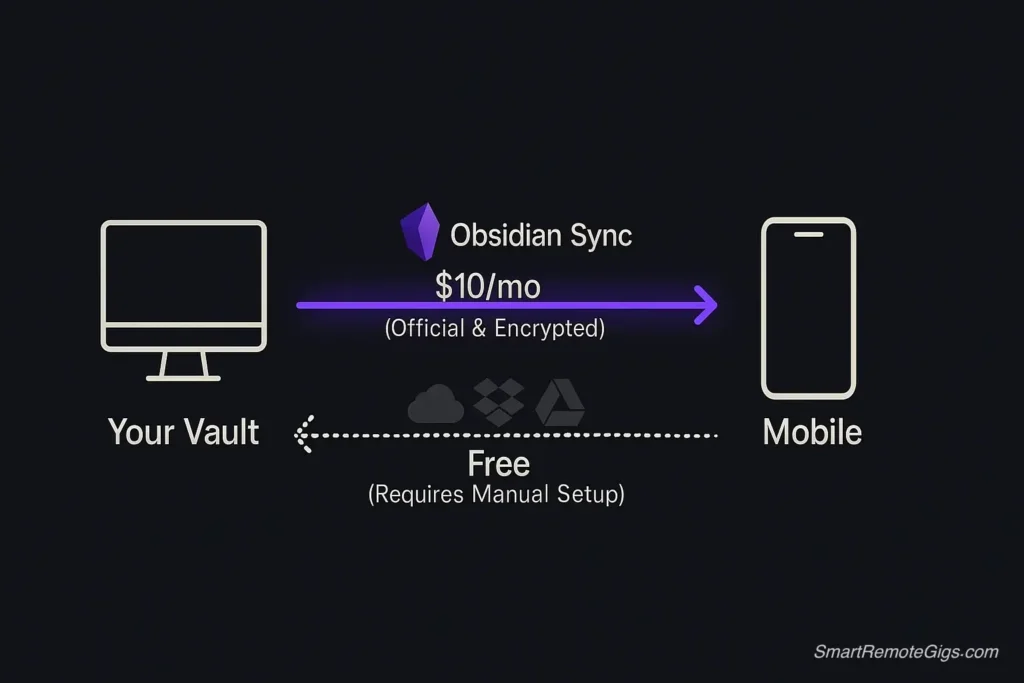
Unlike cloud-first apps, Obsidian doesn’t automatically sync your notes across devices. Your vault lives on your local device, which means accessing it from multiple devices requires additional setup.
Obsidian offers Obsidian Sync ($10/month) for seamless cloud synchronization with end-to-end encryption. It’s fast, reliable, and preserves all Obsidian-specific features like plugin data and custom themes.
Free alternatives include using iCloud Drive, Google Drive, Dropbox, or Syncthing to sync your vault folder. These work well for basic syncing but may not handle rapid changes from multiple devices as gracefully as the official solution. Some users report occasional conflicts when editing the same note on different devices simultaneously.
Mobile apps exist for both iOS and Android, but they’re not as feature-rich as the desktop version. Plugin support is limited, and complex layouts don’t translate well to small screens. Obsidian works best with a desktop-first workflow supplemented by mobile access.
It’s for You, Not Your Team
Obsidian excels at personal knowledge management but struggles with team collaboration. While you can share vaults and collaborate on notes, it lacks the real-time editing, permission systems, and collaborative features that make apps like Notion or Roam effective for teams.
The local-first approach means each collaborator needs their own copy of the vault, and merging changes requires manual coordination or external sync solutions. Comments, suggestions, and approval workflows don’t exist.
Some teams use Obsidian successfully by treating it as a personal research and thinking tool that feeds into collaborative platforms. Individuals build comprehensive knowledge bases in Obsidian, then share insights and polished content through team-appropriate tools.
💰 Obsidian Pricing: “Free for Life” Explained
Obsidian operates on a unique pricing model that reflects its user-ownership philosophy. The core app is free for personal use forever—no feature limitations, no time restrictions, no advertising.
Personal Use (Free):
- Full access to all core features
- Unlimited notes and vaults
- Complete plugin ecosystem
- Local storage and privacy
- Community support
Commercial License ($50/user/year):
Required if you use Obsidian for business purposes with revenue over $1 million annually. Most individual professionals, freelancers, and small businesses qualify for free personal use.
Optional Add-On Services:
- Obsidian Sync ($10/month): Official cloud sync with end-to-end encryption
- Obsidian Publish ($20/month): Turn your notes into a public website
The free-forever model means you can invest years in building your knowledge base without worrying about subscription increases or feature removals. Even if you eventually pay for sync or publish, the core value—your notes and the app itself—remains free.
This pricing strategy attracts users who value long-term thinking over short-term convenience. You’re not renting access to your thoughts; you’re building a permanent digital asset.
🔄 How Obsidian Compares to Alternatives in 2025
The knowledge management landscape has evolved significantly, but Obsidian maintains unique advantages:
vs. Notion: Notion excels at team collaboration and structured databases. Obsidian wins for personal knowledge building, speed, and privacy. Notion is better for teams; Obsidian is better for thinkers.
vs. Roam Research: Roam pioneered bidirectional linking and block-based thinking. Obsidian offers similar concepts with better performance, lower cost, and local storage. Roam’s daily notes and block references feel more dynamic; Obsidian’s file-based approach feels more permanent.
vs. Logseq: Logseq offers similar local-first philosophy with block-based structure. Obsidian’s plugin ecosystem is more mature, and its file-based approach appeals to users who prefer traditional document structures.
vs. RemNote: RemNote combines note-taking with spaced repetition learning. Obsidian focuses purely on knowledge connection and retrieval. RemNote is better for active studying; Obsidian excels at long-term knowledge building.
The Reality: No single tool dominates every use case. Obsidian’s strength lies in personal, long-term knowledge building for people who think in networks rather than hierarchies.
📊 Real-World Use Cases: Where Obsidian Excels
Academic Research
PhD students use Obsidian to manage literature reviews spanning hundreds of papers. Each paper becomes a note with key insights, methodology, and connections to other research. The graph view reveals research clusters and gaps, while linking helps build comprehensive arguments for dissertations.
Creative Writing
Novelists build interconnected worlds with character notes, plot threads, and thematic elements all linked together. The ability to jump between character backgrounds, plot outlines, and scene drafts without losing context helps maintain consistency across complex narratives.
Professional Development
Consultants and knowledge workers build personal knowledge bases that capture insights from projects, books, conferences, and conversations. Over time, this becomes a searchable repository of professional expertise that informs client work and business decisions.
Personal Learning
Lifelong learners create comprehensive knowledge maps that connect insights from books, podcasts, courses, and personal experiences. The linking system helps synthesize information from diverse sources into coherent understanding and actionable insights.
📊 Real-World Use Cases: Where Obsidian Excels
Go Deeper with Obsidian:
Ready to build your own networked brain? These guides will show you how:
- The Core Methodology: Our step-by-step guide to Zettelkasten in Obsidian: A Step-by-Step Beginner’s Guide is the perfect place to start.
- Direct Comparison: Understand the philosophical differences in our head-to-head analysis: Obsidian vs. Notion: Which is the Best “Second Brain” App?.
- Practical Application: Learn the principles of building a long-term knowledge asset in our How to Build a Second Brain starter guide.
🏁 Conclusion: Is Obsidian the Right Tool for You?
After extensive use and comparison with alternatives, Obsidian remains unmatched for individuals who want to build a truly personal, permanent knowledge base. Its combination of local storage, flexible linking, and infinite customization creates possibilities that cloud-based apps simply cannot match.
But Obsidian demands something that many modern apps have trained us not to expect: patience and intentional setup. It’s not a productivity hack or a quick solution. It’s a long-term investment in how you think, research, and build knowledge.
Choose Obsidian if:
- You think in connections rather than categories
- Privacy and data ownership are important to you
- You’re building long-term projects that require deep research
- You enjoy customizing tools to match your exact workflow
- You want your knowledge base to outlast any specific company or platform
Look elsewhere if:
- You need immediate productivity without setup time
- Team collaboration is your primary requirement
- You prefer cloud-based access across devices without technical configuration
- Simple, linear note-taking meets all your needs
Obsidian isn’t just a note-taking app—it’s a commitment to thinking deeply and building knowledge that lasts. For the right person, that commitment transforms not just how you take notes, but how you think about ideas, learning, and the digital legacy you’re building.
The question isn’t whether Obsidian is good—it’s whether you’re the type of person it was designed for. If you value ownership over convenience, depth over simplicity, and building over consuming, then Obsidian might just change how you think.
Ready to explore more knowledge management options? Check out our comprehensive Best Note-Taking Apps of 2025 guide, or dive deeper with our Obsidian vs. Notion comparison for team-focused workflows.
Obsidian Review 2025: The Ultimate App for Thinkers
Obsidian
A powerful, local-first note-taking app that helps you build a personal, interconnected knowledge base using plain text Markdown files you own and control.
Final Verdict: For those who want to build a truly personal, lasting knowledge base, Obsidian is unmatched. It’s an investment in long-term thinking, not just another app.
Editor’s Rating:
Price: Free
Visit Website